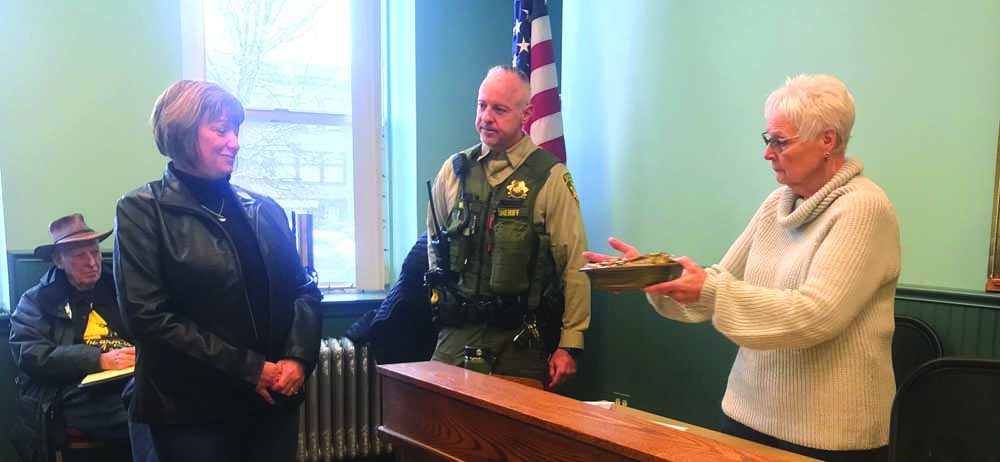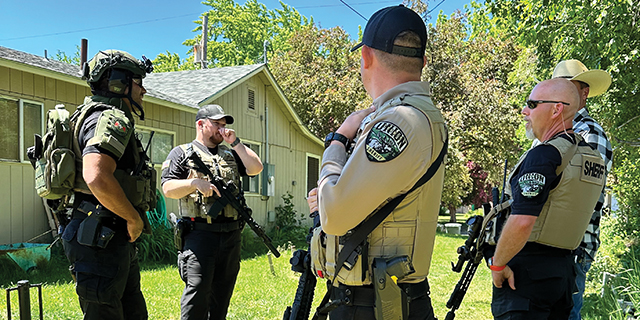It’s time to take a hike
Published 2:29 pm Friday, June 8, 2012

- A paved, wheelchair-accessible trail follows the Powder River for about one mile at the Powder River Recreation Area along Highway 7, about 15 miles southwest of Baker City. A wide, well-graded gravel trail parallels the river on the opposite bank. The Recreation Area also includes wooden fishing platforms accessible to anglers in wheelchairs. S. JOHN COLLINS / Baker City Herald
Lower-elevation trails beckon trekkers
The lingering snow that mantles the high peaks of the Wallowa and Elkhorn mountain ranges presents a pretty scene in these waning days ofspring.
Unless you want to go hiking up there.
In which case those comely drifts are a plain old nuisance.
But even though the alpine country remains snowbound, there’s an abundance of lower-elevation trails across Northeastern Oregon that won’t tax either your patience (few hikers relish slogging through miles of slush) or your route-finding skills.
This network of snow-free trails runs the gamut from the slopes of Hells Canyon, where you’re as apt to find a prickly pear cactus as a ponderosa pine, to the dense conifer forests of the Blue Mountains, said Dan Ermovick, recreation program manager for the Wallowa-Whitman National Forest.
“The snow is melting off the trails,” Ermovick said Wednesday. “We want hikers to enjoy themselves, but because the trails haven’t been maintained they should be prepared for trees across the trail and, of course, for changing weather conditions.”
The vagaries of this past week illustrated Ermovick’s latter point with considerable clarity.
Following are a handful of Ermovick’s recommended hiking areas:
Powder River/Phillips Reservoir near Baker City
Trails in this area, about 17 miles southwest of Baker City via Highway 7, range from the long-but-level stroll around Phillips Reservoir to the short climb to Indian Rock, a basaltic knob that overlooks the 2,400-acre reservoir.
Less than a mile downriver from the reservoir, just off Highway 7, there’s the Powder River Recreation Area, which includes about two miles of wheelchair-accessible trails (some paved, some gravel) as well as fishing platforms.
The Phillips Shoreline trail, which totals about 15 miles, is also popular with mountain bikers.
If you haven’t the time or inclination to circle the reservoir, you can hike or bike sections of two or three miles. There are several trailheads, including:
andbull; Mason Dam (both north and south shores)
andbull; Mason Dam boat launch, Union Creek Campground, Social Security Point and Mowich Loop picnic area, all on the north side, adjacent to Highway 7.
There is a day-use fee at Union Creek Campground, but the other sites are free.
andbull; Southwest Shore and Millers Lane campgrounds, both on the south side of the reservoir, accessible via Hudspeth Lane (paved) and Forest Road 2220 (well-graded gravel).
The 1.5-mile Indian Rock trail starts on the north side of Highway 7, across from the entrance road to Union Creek Campground.
Regardless of which trail you pick, expect ticks.
The blood-sucking arachnids, which are about the size of a grain of rice, inhabit most of the region but they seem to be especially numerous in the Phillips Reservoir vicinity.
Insect repellents can help discourage ticks. When applying bug dope, pay particular attention to your lower leg, as ticks climb aboard their human hosts by latching on when we walk through tall grass or brush.
When you’re finished with your hike, check your clothing (and underneath) for the telltale black dot freckle that denotes you’ve taken on an unwanted passenger.
If the tick has embedded itself in your skin (you probably won’t feel any pain), use tweezers to carefully pluck out the pest.
Hells Canyon National Recreation Area/Wallowa County
From the trailhead near Homestead, just north of Oxbow off Highway 86 (about 70 miles east of Baker City), hikers can follow the Snake River downstream, or branch off on trails that climb the western rim.
Hikers should be wary of rattlesnakes and poison oak, as well as the aforementioned ticks. Remember, too, that some trails in this area are below 2,000 feet elevation, so temperatures typically run 10 to 15 degrees warmer than in the Baker, Grande Ronde and Wallowa valleys.
Another worthwhile destination, Ermovick said, is the Imnaha River trail.
To get there, drive the Wallowa Loop Road (Forest Road 39) either south from Joseph or north from near Halfway. The paved road has been open since Memorial Day weekend, Ermovick said.
The trail starts at Indian Crossing campground, the farthest upriver of the four Forest Service campgrounds along Forest Road 3960 west of the Loop Road – Coverdale, Hidden and Evergreen make up the rest of the quartet.
On the northern end of Hells Canyon, the Snake River trail, which is accessible at Dug Bar northeast of Imnaha, is snow-free.
La Grande area
Bird Track Interpretive Site, along Highway 244 near Hilgard, is well-suited to families with young kids who aren’t up to day-long hikes or steep grades, Ermovick said.
He also recommends the Oregon Trail Interpretive Park at Blue Mountain Crossing, just off Interstate 84 between La Grande and Meacham.
Lower sections of trails in the Catherine Creek and main Eagle Creek areas southeast of Union are melting out, Ermovick said, but access to the various lake basins is still impeded by snow.
Elkhorn Mountains
Always one of the early trails to open, the path along Dutch Flat Creek, near the Anthony Lakes Highway, also has an unusual variety of scenery and topography.
The trailhead is at the end of Forest Road 7307. The elevation is 4,900 feet – relatively low for a range that crests at 9,106 feet atop Rock Creek Butte.
After climbing for a half-mile through an eclectic forest of ponderosa pine, Douglas-fir and an occasional tamarack, the trail rounds a ridge and heads up a canyon where its namesake creek careens between granite boulders with a hollow roar that you can hear well before you actually see the water.
The trail continues up the gorge, which was carved by a glacier during the Ice Age, when both the Elkhorns and Wallowas were festooned with these slow-moving rivers of ice.
A good turnaround spot is at Van Patten Creek, a tributary that flows into Dutch Flat Creek about three miles from the trailhead. The trail continues for seven miles, passing Dutch Flat (actually a classic alpine meadow) and Dutch Flat Lake before joining the Elkhorn Crest Trail. Snow still blocks the upper five miles or so.





